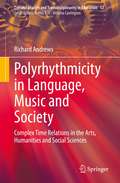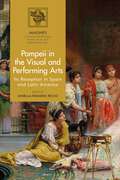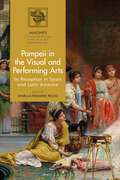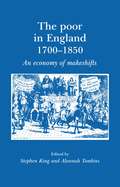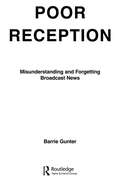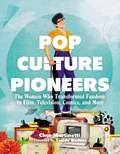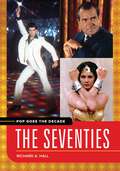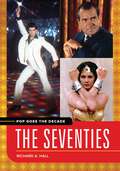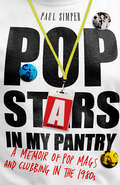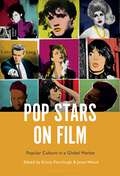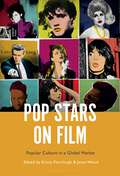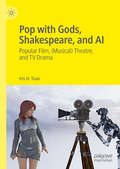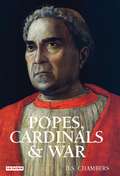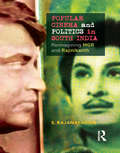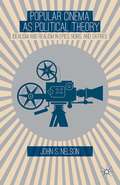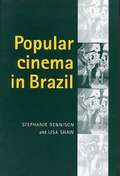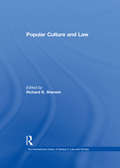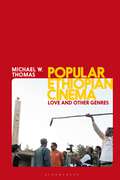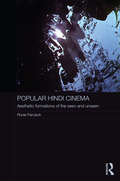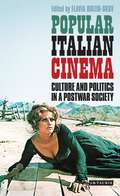- Table View
- List View
Polyrhythmicity in Language, Music and Society: Complex Time Relations in the Arts, Humanities and Social Sciences (Cultural Studies and Transdisciplinarity in Education #12)
by Richard AndrewsThis book addresses the complex time relations that occur in some types of jazz and classical music, as well as in the novel, plays and poetry. It discusses these multiple levels of rhythm from a social science as well as an arts and humanities perspective. Building on his ground-breaking work in Re-framing Literacy, A Prosody of Free Verse and Multimodality, Poetry and Poetics, the author explores the world of multiple- or poly-rhythms in music, literature and the social sciences. He reveals that multi-layered rhythms are uncommon and little researched. Nevertheless, they are important to the experience of art and social situations, not least because they link physicality to feeling and to decision-making (timing), as well as to aesthetic experience. Whereas most poly-rhythmic relations are felt unconsciously, this book reveals the complex patterning that underpins the structures of feeling and of experience.
Pompeii in the Visual and Performing Arts: Its Reception in Spain and Latin America (IMAGINES – Classical Receptions in the Visual and Performing Arts)
by Mirella Romero RecioThis volume examines the influence that Pompeii and, to a lesser extent, Herculaneum had on the visual and performing arts in Spain and countries across South America. Covering topics from architecture, painting and decorative arts to theatre, dance and photography, the reader will gain insight into the reception of classical antiquity through the analysis of the close cultural ties between both sides of the Atlantic, in the past and the present. Each contribution has been written by a specialist researcher participating in the project, 'The Reception and Influence of Pompeii and Herculaneum in Spain and Ibero-America', funded by the Spanish Ministry of Science and Innovation (PGC2018-093509-B-I00 Ministry of Science and Innovation/AEI/ERDF/EU).Pompeii in the Visual and Performing Arts begins by examining the influence of Pompeiian architecture in Spain in paintings that depict scenes inspired by Roman scenes and also buildings modelled on those of Pompeii. Next, the influence of Pompeii crosses the Atlantic to Mexico with a study of the archaeological site's influence on the visual and performing arts. An exploration of the elitist use of the ancient past in architecture is seen in Chilean architecture, which leads onto an investigation of the new art styles that emerged in the 19th century. Later chapters look into the influence of the ancient frescoes and the use of modern plaster casts of statues. The final chapters are devoted to comics and photography, which also make a study of the places in Latin America nicknamed 'Pompeii' in the 20th and 21st centuries.
Pompeii in the Visual and Performing Arts: Its Reception in Spain and Latin America (IMAGINES – Classical Receptions in the Visual and Performing Arts)
This volume examines the influence that Pompeii and, to a lesser extent, Herculaneum had on the visual and performing arts in Spain and countries across South America. Covering topics from architecture, painting and decorative arts to theatre, dance and photography, the reader will gain insight into the reception of classical antiquity through the analysis of the close cultural ties between both sides of the Atlantic, in the past and the present. Each contribution has been written by a specialist researcher participating in the project, 'The Reception and Influence of Pompeii and Herculaneum in Spain and Ibero-America', funded by the Spanish Ministry of Science and Innovation (PGC2018-093509-B-I00 Ministry of Science and Innovation/AEI/ERDF/EU).Pompeii in the Visual and Performing Arts begins by examining the influence of Pompeiian architecture in Spain in paintings that depict scenes inspired by Roman scenes and also buildings modelled on those of Pompeii. Next, the influence of Pompeii crosses the Atlantic to Mexico with a study of the archaeological site's influence on the visual and performing arts. An exploration of the elitist use of the ancient past in architecture is seen in Chilean architecture, which leads onto an investigation of the new art styles that emerged in the 19th century. Later chapters look into the influence of the ancient frescoes and the use of modern plaster casts of statues. The final chapters are devoted to comics and photography, which also make a study of the places in Latin America nicknamed 'Pompeii' in the 20th and 21st centuries.
The poor in England 1700–1850: An economy of makeshifts
by Alannah Tomkins Steven KingThis fascinating study investigates the experience of English poverty between 1700 and 1900 and the ways in which the poor made ends meet. The phrase ‘economy of makeshifts’ has often been used to summarise the patchy, desperate and sometimes failing strategies of the poor for material survival. In The poor of England some of the leading, young historians of welfare examine how advantages gained from access to common land, mobilisation of kinship support, resorting to crime, and other marginal resources could prop up struggling households. The essays attempt to explain how and when the poor secured access to these makeshifts and suggest how the balance of these strategies might change over time or be modified by gender, life-cycle and geography. This book represents the single most significant attempt in print to supply the English ‘economy of makeshifts’ with a solid, empirical basis and to advance the concept of makeshifts from a vague but convenient label to a more precise yet inclusive definition.
Poor Reception: Misunderstanding and Forgetting Broadcast News (Routledge Communication Series)
by Barrie GunterPublished in 1990, Poor Reception is a valuable contribution to the field of Communication Studies.
Poor Reception: Misunderstanding and Forgetting Broadcast News (Routledge Communication Series)
by Barrie GunterPublished in 1990, Poor Reception is a valuable contribution to the field of Communication Studies.
Pop Culture Pioneers: The Women Who Transformed Fandom in Film, Television, Comics, and More
by Cher MartinettiCelebrate the empowering and inspiring women who helped create, shape, and make pop culture great, from the creator of SYFY WIRE's FANGRRLS and the podcast "Forgotten Women of Genre"! In every medium in popular culture—from books, films, and video games to comics, television, and animation—women have been instrumental in creating and shaping the worlds, characters, and genres that we know and love. However, much of their hard work and innovation has gone largely unrecognized—until now. With a foreword by American Gods actress Yetide Badaki and essays exploring the history and transformation of pop culture's genres and mediums, Pop Culture Pioneers explores and pays respect to the women who played a crucial role in creating and influencing of some of the most famous worlds and characters in pop culture including:Directors & Producers like Karyn Kusama (Aeon Flux, Jennifer's Body), Denise Di Novi (co-producer of Batman Returns, The Nightmare Before Christmas), and Jean MacCurdy (producer of Batman: The Animated Series, Animaniacs)Writers & Editors like Jeanette Khan (editor and publisher of DC Comics), Alice Bradley Sheldon (writing as James Tiptree Jr.), and Alison Bechdel (Fun Home)Animators & Artists like Rebecca Sugar (Steven Universe), Noelle Stevenson (She-Ra and the Princesses of Power) and Brenda Chapman (animator and director of Brave)As well as Marlene Clark (Blaxploitation actress), Roberta Williams (creator of the adventure game genre), Yvonne Blake (costume designer for Superman), Bonnie Erickson (co-creator of Miss Piggy), and many more.
Pop Goes the Decade: The Seventies (Pop Goes the Decade)
by Richard A. HallPart of the Pop Goes the Decade series, this book looks at one of the most memorable decades of the 20th century, highlighting pop culture areas such as film, television, sports, technology, advertising, fashion, and art.All in the Family. Barry Manilow, Donna Summer, and Olivia Newton-John; Styx, Led Zeppelin, and The Jackson Five. Jaws, Rocky, The Exorcist, and The Rocky Horror Picture Show. Pop Goes the Decade: The Seventies takes a sweeping look at all of the cultural events and developments that made the 1970s a highly memorable era of change and new thinking.This book explores the cultural and social framework of the 1970s, focusing on pop culture areas that include film, television, sports, technological innovations, clothing, and art. A timeline highlights significant cultural moments, and a "controversies in pop culture" section explores the pop culture items and moments of the 1970s that shocked the public and challenged underlying social mores. The book also includes a "Game Changers" section that identifies the public figures and celebrities who had the largest influence during the decade, a technology section that explains how media, news, and culture were shared, and a "Legacy" section that identifies concepts and events from the 1970s that still affect Americans today.
Pop Goes the Decade: The Seventies (Pop Goes the Decade)
by Richard A. HallPart of the Pop Goes the Decade series, this book looks at one of the most memorable decades of the 20th century, highlighting pop culture areas such as film, television, sports, technology, advertising, fashion, and art.All in the Family. Barry Manilow, Donna Summer, and Olivia Newton-John; Styx, Led Zeppelin, and The Jackson Five. Jaws, Rocky, The Exorcist, and The Rocky Horror Picture Show. Pop Goes the Decade: The Seventies takes a sweeping look at all of the cultural events and developments that made the 1970s a highly memorable era of change and new thinking.This book explores the cultural and social framework of the 1970s, focusing on pop culture areas that include film, television, sports, technological innovations, clothing, and art. A timeline highlights significant cultural moments, and a "controversies in pop culture" section explores the pop culture items and moments of the 1970s that shocked the public and challenged underlying social mores. The book also includes a "Game Changers" section that identifies the public figures and celebrities who had the largest influence during the decade, a technology section that explains how media, news, and culture were shared, and a "Legacy" section that identifies concepts and events from the 1970s that still affect Americans today.
Pop Stars in My Pantry: A Memoir of Pop Mags and Clubbing in the 1980s
by Paul SimperCorrupted by Spandau. Slated by Boy George. Mothered by Sade. Evicted by Bananarama. Jilted by Madonna.Author, columnist and TV writer Paul Simper had a front-row seat at one of pop stardom’s most exciting shows: the 1980s. His memoir, Pop Stars in My Pantry, is an account of a wide-eyed, wet-behind-the-ears lad from Wiltshire landing in London just as the capital’s club scene went into orbit. As a pop writer and fellow clubber, he had unique access to the artists who would become the biggest pop acts of the decade.On any given day, he might be required to fly a reader to the other side of the world to hang out with Spandau Ballet, accompany Bananarama’s Keren and Wham!’s George Michael on a blind date, help Frankie Goes to Hollywood chuck furniture out of TV studio windows in Rome, watch Boy George styling and flirting with Paul Weller in fake furs, or walk off into the sunset with a newbie called Madonna. It is also the tale of his own attempts at pop stardom with the help of former ’Nana Miss Jacqueline O’Sullivan and an unexpected bonus career as a showbiz party DJ for the likes of Prince, Whitney, Elton and even Al Pacino.This is an endlessly entertaining, behind-the-scenes ride – the ultimate back-stage pass – for 1980s pop enthusiasts and lovers of Smash Hits… from the man who saw it all.
Pop Stars on Film: Popular Culture in a Global Market
by Kirsty Fairclough and Jason WoodPop stars have provided audiences with performative moments that have become ingrained in popular consciousness. They are a lens through which deeper understandings about race, gender, politics, history and the artistic process can be understood. When combined with the most affective of mediums – cinema, the combination can be both thrilling and alarming.From the relatively early days of cinema, figures from the world of popular music have made forays into acting and contributed cameo appearances. From Little Richard and Kylie Minogue to Nick Cave and Tom Waits, Pop Stars On Film: Popular Culture in a Global Market offers a collection of essays on some of the most influential international performances from a diverse range of cultural icons. The book considers industry shifts, access and diversity, but also the notion of cultural appropriation, audience appeal, marketing and demographics. Perhaps most importantly, the publication will look at what happens when cultures collide and coalesce.
Pop Stars on Film: Popular Culture in a Global Market
Pop stars have provided audiences with performative moments that have become ingrained in popular consciousness. They are a lens through which deeper understandings about race, gender, politics, history and the artistic process can be understood. When combined with the most affective of mediums – cinema, the combination can be both thrilling and alarming.From the relatively early days of cinema, figures from the world of popular music have made forays into acting and contributed cameo appearances. From Little Richard and Kylie Minogue to Nick Cave and Tom Waits, Pop Stars On Film: Popular Culture in a Global Market offers a collection of essays on some of the most influential international performances from a diverse range of cultural icons. The book considers industry shifts, access and diversity, but also the notion of cultural appropriation, audience appeal, marketing and demographics. Perhaps most importantly, the publication will look at what happens when cultures collide and coalesce.
Pop with Gods, Shakespeare, and AI: Popular Film, (Musical) Theatre, and TV Drama
by Iris H. TuanApplying the theories of Popular Culture, Visual Culture, Performance Studies, (Post)Feminism, and Film Studies, this interdisciplinary and well-crafted book leads you to the fascinating and intriguing world of popular film, (musical) theatre, and TV drama. It explores the classical and contemporary cases of the literature works, both Eastern and Western, adapted, represented and transformed into the interesting artistic medium in films, performances, TV dramas, musicals, and AI robot theatre/films. ‘Iris Tuan’s book is wide ranging in scope and diversity, examining theatre, music, film and television productions from both Western and Asian countries. Tuan also surveys an extensive range of critical and theoretical perspectives, especially from performance studies and popular cultural studies, to offer context for her descriptions of the many different works. Some of her examples are well-known (Shakespeare’s Romeo & Juliet, Disney’s The Lion King) while others little known outside their place of origin (such as the Hakka Theatre of Taiwan) -- all are approached by the author with enthusiasm.’ —Susan Bennett, Professor of English, University of Calgary, Canada ‘Tuan takes us through multiple examples of contemporary popular performance in theatre/film/TV ranging from "high" art sources (Shakespeare or Journey to the West in films, Hirata's robotic theatre experiments) to "low" (Taiwanese TV soap operas Hakka Theatre: Roseki and Story of Yangxi Palace, Korean film Along with the Gods: The Two Worlds). The reader moves at a speed-dating pace through contemporary culture production and interpretive theories, encountering significant works, controversies (i. e., yellow face), and conundrums selected from China, Korea, Japan and the U. S. and filtered through a Taiwanese female gaze.’ —Kathy Foley, Professor of Theatre Arts, University of California Santa Cruz, USA
Popes, Cardinals and War: The Military Church in Renaissance and Early Modern Europe
by D.S. ChambersCan Christian clergy – supposedly men of peace –also be warriors? In this lively and compelling history D.S. Chambers examines the popes and cardinals over several centuries who not only preached war but also put it into practice as military leaders. Satirised by Erasmus, the most notorious – Julius II – was even refused entrance to heaven because he was 'bristling and clanking with bloodstained armour'. Popes, Cardinals and War investigates the unexpected commitment of the Roman Church, at its highest level of authority, to military force and war as well as – or rather than – peace-making and the avoidance of bloodshed. Although the book focuses particularly on the fifteenth and sixteenth centuries, a notoriously belligerent period in the history of the papacy, Chambers also demonstrates an extraordinary continuity in papal use of force, showing how it was of vital importance to papal policy from the early Middle Ages to the nineteenth century. Popes, Cardinals and War looks at the papacy's stimulus and support of war against Muslim powers and Christian heretics but lays more emphasis on wars waged in defence of the Church's political and territorial interests in Italy. It includes many vivid portraits of the warlike clergy, placing the exceptional commitment to warfare of Julius II in the context of the warlike activities and interests of other popes and cardinals both earlier and later.Engaging and stimulating, and using references to scripture and canon law as well as a large range of historical sources, Chambers throws light on these extraordinary and paradoxical figures – men who were peaceful by vocation but contributed to the process of war with surprising directness and brutality – at the same time as he illuminates many aspects of the political history of the Church.' Very informative and utterly convincing.It fills a real gap in the literature.'– Professor Michael Mallett, University of Warwick
Popular Cinema and Politics in South India: The Films of MGR and Rajinikanth
by S. RajanayagamThis work breaks new ground in the understanding of South Indian cinema and politics. Through incisive analysis and original concepts it illustrates the private, public and cinematic personas of MGR and Rajinikanth. It challenges the popular and scholarly myths surrounding them and shows the constant negotiation of their on-screen and off-screen identities. The book revisits the entire political history of post-Independent Tamil Nadu through its cinema,and presents a refreshing psycho-political and cultural map of contemporary South India. This absorbing volume will be an important read for scholars, teachers and students of film studies, culture and media studies, and politics, especially those interested in South India.
Popular Cinema and Politics in South India: The Films of MGR and Rajinikanth
by S. RajanayagamThis work breaks new ground in the understanding of South Indian cinema and politics. Through incisive analysis and original concepts it illustrates the private, public and cinematic personas of MGR and Rajinikanth. It challenges the popular and scholarly myths surrounding them and shows the constant negotiation of their on-screen and off-screen identities. The book revisits the entire political history of post-Independent Tamil Nadu through its cinema,and presents a refreshing psycho-political and cultural map of contemporary South India. This absorbing volume will be an important read for scholars, teachers and students of film studies, culture and media studies, and politics, especially those interested in South India.
Popular Cinema as Political Theory: Idealism and Realism in Epics, Noirs, and Satires
by J. NelsonThe book presents cinematic case studies in political realism versus political idealism, demonstrating methods of viewing popular cinema as political theory. The book appreciates political myth-making in popular genres as especially practical and accessible theorizing about politics.
Popular cinema in Brazil, 1930–2001
by Stephanie Dennison Lisa ShawBrazil has one of the most significant and productive film industries in Latin America. This ground-breaking study provides an entertaining insight into the Brazilian films that have most captured the imagination of domestic audiences over the years. The recent international success of films such as Central Station and City of God, has stimulated widespread interest in Brazilian film, but studies written in English focus on the 'auteur' cinema of the 1960s. This book focuses on individual films in their socio-historical context, drawing on extensive fieldwork in Brazil and Latin America. It argues that Brazilian cinema has almost always been grounded in intrinsically home-grown cultural forms, dating back to the nineteenth century, such as the Brazilian music-hall, the travelling circus, radio shows, carnival, and, later, comedy television. Combining a chronological structure with groundbreaking research and a lively approach, Popular cinema in Brazil is the ideal introduction to Brazilian cinema.
Popular Culture and Law
by Richard K. SherwinWhat are the consequences when law's stories and images migrate from the courtroom to the court of public opinion and from movie, television and computer screens back to electronic monitors inside the courtroom itself? What happens when lawyers and public relations experts market notorious legal cases and controversial policy issues as if they were just another commodity? What is the appropriate relationship between law and digital culture in virtual worlds on the Internet? In addressing these cutting edge issues, the essays in this volume shed new light on the current status and future fate of law, truth and justice in our time.
Popular Culture and Law
by RichardK. SherwinWhat are the consequences when law's stories and images migrate from the courtroom to the court of public opinion and from movie, television and computer screens back to electronic monitors inside the courtroom itself? What happens when lawyers and public relations experts market notorious legal cases and controversial policy issues as if they were just another commodity? What is the appropriate relationship between law and digital culture in virtual worlds on the Internet? In addressing these cutting edge issues, the essays in this volume shed new light on the current status and future fate of law, truth and justice in our time.
Popular Ethiopian Cinema: Love and Other Genres (World Cinema)
by Michael W. ThomasThis book shines much-needed light on the history, structures and films of the Amharic film industry in Ethiopia. Focusing on the rise of the industry from 2002, until today, and embedded in archival, ethnographic and textual research methods, this book offers a sustained and detailed appreciation of Amharic-language cinema. Michael Thomas considers 'fiker'/love as an organising principle in national Ethiopian culture and, by extension, Amharic cinema. Placing 'fiker' as central to understanding Amharic film genres also illuminates the continuous negotiations at play between romantic, familial, patriotic and spiritual notions of love in these films. Thomas considers the production and exhibition of films in Ethiopia, charting fluctuations and continuities between the past and the present. Having done so, he offers detailed textual readings of films, identifying important junctures in the industry's development and the emergence of new genres. The findings of the book detail the affective characteristics that delineate most Amharic genres and the role culturally specific concepts, such as fiker, play in maintaining the relevance of commercial cinemas reliant on domestic audiences.
Popular Ethiopian Cinema: Love and Other Genres (World Cinema)
by Michael W. ThomasThis book shines much-needed light on the history, structures and films of the Amharic film industry in Ethiopia. Focusing on the rise of the industry from 2002, until today, and embedded in archival, ethnographic and textual research methods, this book offers a sustained and detailed appreciation of Amharic-language cinema. Michael Thomas considers 'fiker'/love as an organising principle in national Ethiopian culture and, by extension, Amharic cinema. Placing 'fiker' as central to understanding Amharic film genres also illuminates the continuous negotiations at play between romantic, familial, patriotic and spiritual notions of love in these films. Thomas considers the production and exhibition of films in Ethiopia, charting fluctuations and continuities between the past and the present. Having done so, he offers detailed textual readings of films, identifying important junctures in the industry's development and the emergence of new genres. The findings of the book detail the affective characteristics that delineate most Amharic genres and the role culturally specific concepts, such as fiker, play in maintaining the relevance of commercial cinemas reliant on domestic audiences.
Popular Hindi Cinema: Aesthetic Formations of the Seen and Unseen (Routledge Contemporary South Asia Series)
by Ronie ParciackThe popular Hindi film industry is the largest in India and the most conspicuous film industry in the non-Western world. This book analyses the pivotal visual and narrative conventions employed in popular Hindi films through the combined prism of film studies and classical Indian philosophy and ritualism. The book shows the films outside Western paradigms, as visual manifestations and outcomes of the evolution of classical Hindu notions and esthetic forms. These include notions associated with the Advaita-Vedānta philosophical school and early Buddhist thought, concepts and dynamism stemming from Hindu ritualism, rasa esthetic theories, as well as Brahmanic notions such as dharma (religion, law, order), and mokṣa (liberation). These are all highly abstract notions which the author defines as "the unseen": a cluster of diversified concepts denoting what subsists beyond the phenomenal, what prevails beyond the empirical world of saṁsāra and stands out of this world (alaukika), while simultaneously being embodied and transformed within visual filmic imagery, codes and semiotics that are teased out and analyzed. A culturally sensitive reading of popular Hindi films, the interpretations put forward are also applicable to the Western context. They enable a fuller understanding of religious phenomena outside the primary religious field, within the vernacular arenas of popular culture and mass communication. The book is of interest to scholars in the fields of Indology, modern Indian studies, film, media and cultural studies.
Popular Hindi Cinema: Aesthetic Formations of the Seen and Unseen (Routledge Contemporary South Asia Series)
by Ronie ParciackThe popular Hindi film industry is the largest in India and the most conspicuous film industry in the non-Western world. This book analyses the pivotal visual and narrative conventions employed in popular Hindi films through the combined prism of film studies and classical Indian philosophy and ritualism. The book shows the films outside Western paradigms, as visual manifestations and outcomes of the evolution of classical Hindu notions and esthetic forms. These include notions associated with the Advaita-Vedānta philosophical school and early Buddhist thought, concepts and dynamism stemming from Hindu ritualism, rasa esthetic theories, as well as Brahmanic notions such as dharma (religion, law, order), and mokṣa (liberation). These are all highly abstract notions which the author defines as "the unseen": a cluster of diversified concepts denoting what subsists beyond the phenomenal, what prevails beyond the empirical world of saṁsāra and stands out of this world (alaukika), while simultaneously being embodied and transformed within visual filmic imagery, codes and semiotics that are teased out and analyzed. A culturally sensitive reading of popular Hindi films, the interpretations put forward are also applicable to the Western context. They enable a fuller understanding of religious phenomena outside the primary religious field, within the vernacular arenas of popular culture and mass communication. The book is of interest to scholars in the fields of Indology, modern Indian studies, film, media and cultural studies.
Popular Italian Cinema: Culture and Politics in a Postwar Society (International Library of Visual Culture)
by Flavia Brizio-SkovWith its monsters, vampires and cowboys, Italian popular culture in the postwar period has generally been dismissed as a form of evasion or escapism. Here, four international scholars re-examine and reinterpret the era to show that popular Italian cinema was not only in tune with contemporary political and social trends, it also presaged the turmoil and rebellion of the 1960s and 1970s.Through a perceptive analysis of the cultural and political atmosphere of the times, we come to see how the changes wrought by modernization, urbanization, the rise of consumerism and the sexual revolution were reflected in popular cinema. The 'sword and sandal' film, based on Greco-Roman mythology and starring body-builders, was linked to the increasing conservatism and growing politicization of Italian film and society. Anxieties unleashed by the sexual revolution found expression in horror films and in the spaghetti western, particularly in violence against women, as a result of growing male anxiety towards female emancipation and a crisis in the prevailing patriarchal order. Comedy Italian-style re-worked the impact of the economic boom and a consumerist lifestyle, as a new middle-class recognized itself at the cinema.Together, this array of cinematic visions conveyed a plurality of messages that ranged from the more conservative and pro-establishment to the more rebellious and pro-revolutionary, at the same time that they responded to the emotional needs of an emerging mass audience and offered ways of binding together an increasingly distressed social order. With striking insights into the links between popular culture and politics, Popular Italian Cinema will be indispensable for specialists in film and media studies, Italian and cultural studies, as well as social history.
